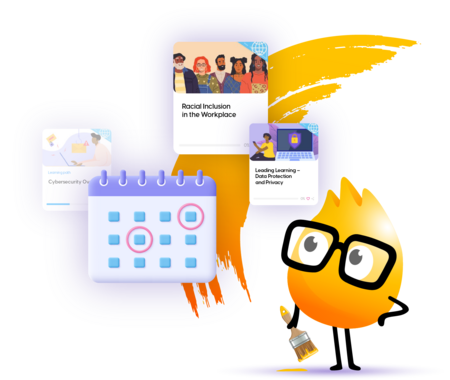Selling is hard. Training shouldn’t make it harder.

It’s no surprise that sales can be such a high-stress, high-turnover job: the turnover for sales representatives hovers around 33%, three times the turnover of all other jobs in the U.S. After the Great Resignation in 2021, turnover rates rose even more, ending up 58% higher than they were in 2020.
A lot is required of salespeople. They need extensive and continuous training to meet those expectations. Unfortunately, the number-one thing reps never have time for is – you guessed it – training. It’s not that salespeople don’t want to learn. In fact, good sales reps are constantly learning. But by enabling sales teams to learn through easier, more accessible, faster – and even enjoyable – training, companies can empower sales reps to sell more.
We’re not helping salespeople win.
Some say selling has changed from “the old days,” but maybe it isn’t selling that’s changed. Rather, the processes and tools that sales reps use haven’t kept pace with customers’ access to information.
As a result, many organizations today still send new sales reps to a central location for a “boot camp” (i.e., onboarding) and expect the reps to be fully equipped from that point forward. Ideally, those sales reps receive periodic product or skills training after onboarding. Unfortunately, this type of sporadic training negatively impacts retention. What reps need is continuous learning and enablement.
Sales reps learn more when they have varied methods of training and a good balance of self-paced courses and in-person training. But most importantly, sales training is not one-size-fits-all. Your newbies have different needs than successful, tenured reps, who likely need different learning paths than middle-of-the-road reps who may be struggling.
Why is personalized training so important?
Even with limitless access to information online, customers still expect sales reps to be more knowledgeable than they are. Customers demand prompt and quality response times and service. It’s well documented that personalized experiences impact customer loyalty, which directly affects the bottom line regardless of your industry. In fact, Customer Experience (CX) leaders show an annual growth rate of 17%, compared with a mere 3% for the CX laggards. Studies show that strong customer service pays dividends: 94% of customers say good customer service makes them more likely to make another purchase. According to Bain & Company, improving customer retention rates by just 5% can increase profits by 25 to 95%.
Businesses that lag in Customer Experience (CX), on the other hand, face mounting challenges. Unhappy customers are more likely to spread the word of a bad experience than a good one, and businesses providing bad CX are less likely to know it; that’s because only about 1 in 26 unhappy customers actually complain to the company. To make things more difficult, customers now expect more from vendors: 60% of service professionals say customer expectations increased over the last few years.
Is it time to refresh your sales training approach?
The time investment and expense of onboarding, as well as the lack of engagement and alignment that can arise from poor training, are all factors that can prevent your company from meeting its sales goals.
We’ve outlined these common concerns below, but to explore each in more detail, we recommend downloading our recent ebook, The Six Biggest Sales Challenges and How Training Can Solve Them. It may spark some ideas on how you could improve your sales training program.
Here are some of the biggest challenges we see and hear from companies across industries:
- Sales rep onboarding takes forever.
Depending on what your company sells, it can take three to six months before your rep is productive. When was the last time your company revised your onboarding process? If it wasn’t in recent memory, it may be time to revisit. - Most sales reps are not hitting quota (and not making the money they want)!
Ramped quotas are great for the sales rep’s attainment numbers during that time, but not so much for the manager or company trying to hit targets. - Sales reps are expensive to replace when they leave (and they’re likely leaving because they’re not hitting quota).
Losing a sales rep can cost an average of $2 million in lost sales. The cost of hiring and training a sales rep is certainly part of that expense, but so is the cost of lost productivity as new reps go through the hiring and onboarding process. Making these processes easier by offering engaging, accurate, and accessible training could save your company’s bottom line in the long run… - Sales reps won’t take training that is out of date or inaccessible.
How often is your content updated? What are the different delivery methods for your sales trainings? If your training isn’t relevant and easily accessible by your salespeople, they may turn to external sources – less authoritative ones, or ones less aligned with your business principles – to get the information they need. Try providing sales reps with access to regularly updated, self-paced training on your products, and to general selling skills courses. - Sales reps have different needs.
A sales manager’s team is typically mixed with new hires, reps that have been around a while, and reps that are struggling. Make sure their coaching and learning programs are personalized to their individual needs. - Sales reps are expected to deliver 5-star experiences but don’t receive Customer Experience (CX) training.
This is a head-scratcher, now that we’ve entered the Experience Economy era. Reps should not have to guess what the company’s CX promise is. They need to be trained to deliver it. The good news about cross-training your sales teams in CX is that everyone wins. Your customers have a great experience; reps make more money; and the company earns loyal advocates in both the customers and the employees.
These are all solvable problems with the right training program and platform in place. For further insights, read our paper, The Six Biggest Sales Challenges and How Training Can Solve Them.





